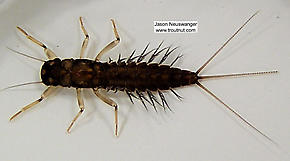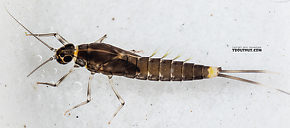Blog & Latest Updates
Fly Fishing Articles
Insects by Common Name


Dark Brown Spinners
Scientific Names
| Match | Scientific Name |
| Paraleptophlebia | |
| Tricorythodes allectus | |
| Drunella coloradensis | |
| Ameletus cooki | |
| Teloganopsis deficiens | |
| Diphetor hageni | |
| Tricorythodes minutus |
Like most common names, "Dark Brown Spinner" can refer to more than one taxon. They're previewed below, along with 9 specimens. For more detail click through to the scientific names.
Mayfly Genus Paraleptophlebia
These are very rarely called Dark Brown Spinners.
There are many species in this genus of mayflies, and some of them produce excellent hatches. Commonly known as Blue Quills or Mahogany Duns, they include some of the first mayflies to hatch in the Spring and some of the last to finish in the Fall.
In the East and Midwest, their small size (16 to 20, but mostly 18's) makes them difficult to match with old techniques. In the 1950s Ernest Schwiebert wrote in Matching the Hatch:
Fortunately, modern anglers with experience fishing hatches of tiny Baetis and Tricorythodes mayflies are better prepared for eastern Paraleptophlebia. It's hard to make sense of so many species, but only one is very important and others can be considered in groups because they often hatch together:
In the East and Midwest, their small size (16 to 20, but mostly 18's) makes them difficult to match with old techniques. In the 1950s Ernest Schwiebert wrote in Matching the Hatch:
"The Paraleptophlebia hatches are the seasonal Waterloo of most anglers, for without fine tippets and tiny flies an empty basket is assured."
Fortunately, modern anglers with experience fishing hatches of tiny Baetis and Tricorythodes mayflies are better prepared for eastern Paraleptophlebia. It's hard to make sense of so many species, but only one is very important and others can be considered in groups because they often hatch together:
- Paraleptophlebia adoptiva is by far the most important species of this genus in the two regions and is an early Spring emerger.
- Paraleptophlebia mollis, Paraleptophlebia guttata, and Paraleptophlebia strigula complement each other in late spring and early summer.
- Paraleptophlebia debilis and Paraleptophlebia praepedita occur together in the fall.
- The most important species is Paraleptophlebia debilis. This large (for the genus) Fall emerger can be found throughout the region. It is often accompanied by one of the slightly larger tusked species. Depending on locale, this can be Paraleptophlebia bicornuta (the most common), Paraleptophlebia packii or Paraleptophlebia helena. Check out their hatch pages for distribution information.
- Spring is the season for the smaller Paraleptophlebia heteronea throughout most of the region with Paraleptophlebia gregalis filling this niche in California and parts of Oregon.
Female Paraleptophlebia (Blue Quills and Mahogany Duns) Mayfly Dun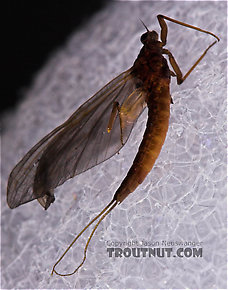 View 4 PicturesI really hoped to catch some good blue quill specimens on this trip, but they are very fragile mayflies and this one was in the best condition of the few that I caught after I drove them home to my camera. It may not be pretty, but you get an idea of the size/shape/color anyway.
View 4 PicturesI really hoped to catch some good blue quill specimens on this trip, but they are very fragile mayflies and this one was in the best condition of the few that I caught after I drove them home to my camera. It may not be pretty, but you get an idea of the size/shape/color anyway.
 View 4 PicturesI really hoped to catch some good blue quill specimens on this trip, but they are very fragile mayflies and this one was in the best condition of the few that I caught after I drove them home to my camera. It may not be pretty, but you get an idea of the size/shape/color anyway.
View 4 PicturesI really hoped to catch some good blue quill specimens on this trip, but they are very fragile mayflies and this one was in the best condition of the few that I caught after I drove them home to my camera. It may not be pretty, but you get an idea of the size/shape/color anyway.Male Paraleptophlebia (Blue Quills and Mahogany Duns) Mayfly Spinner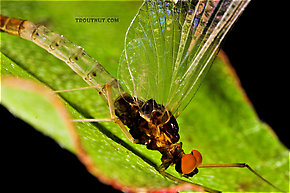 View 15 PicturesI wasn't actually fishing the river where I caught this one. I was just scouting, didn't like the look of the water, and as I was walking back to the car this little dun landed on my vest. Why can't they all be so easy to collect?
View 15 PicturesI wasn't actually fishing the river where I caught this one. I was just scouting, didn't like the look of the water, and as I was walking back to the car this little dun landed on my vest. Why can't they all be so easy to collect?
 View 15 PicturesI wasn't actually fishing the river where I caught this one. I was just scouting, didn't like the look of the water, and as I was walking back to the car this little dun landed on my vest. Why can't they all be so easy to collect?
View 15 PicturesI wasn't actually fishing the river where I caught this one. I was just scouting, didn't like the look of the water, and as I was walking back to the car this little dun landed on my vest. Why can't they all be so easy to collect?Female Paraleptophlebia (Blue Quills and Mahogany Duns) Mayfly Adult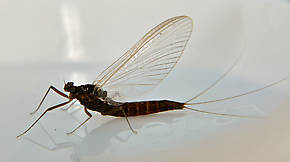 View 1 PicturesThis female exhibits the dark chocolate color so common in this genus.
View 1 PicturesThis female exhibits the dark chocolate color so common in this genus.
 View 1 PicturesThis female exhibits the dark chocolate color so common in this genus.
View 1 PicturesThis female exhibits the dark chocolate color so common in this genus.See 26 more specimens...
Mayfly Species Tricorythodes allectus
These are very rarely called Dark Brown Spinners.
Mayfly Species Drunella coloradensis
These are very rarely called Dark Brown Spinners.
This species is very similar to Drunella flavilinea. In areas where their ranges overlap, they can sometimes be found in the same streams. Allen and Edmunds (1962) say that Drunella coloradensis tends to favor colder water than Drunella flavilinea and that it may emerge as much as a month later.
Drunella coloradensis (Small Western Green Drake) Mayfly Nymph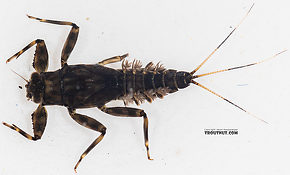 View 11 PicturesThis one nicely illustrates the variation in coloration within an single Ephemerellid species in a single stream, when compared to its lighter, banded counterpart.
View 11 PicturesThis one nicely illustrates the variation in coloration within an single Ephemerellid species in a single stream, when compared to its lighter, banded counterpart.
 View 11 PicturesThis one nicely illustrates the variation in coloration within an single Ephemerellid species in a single stream, when compared to its lighter, banded counterpart.
View 11 PicturesThis one nicely illustrates the variation in coloration within an single Ephemerellid species in a single stream, when compared to its lighter, banded counterpart.Male Drunella coloradensis (Small Western Green Drake) Mayfly Dun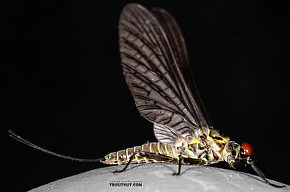 View 8 PicturesThe positive species ID on this dun comes from both the spinner that it (or possibly one other dun just like it) molted into and the overwhelming abundance of nymphs of this species in my kicknet samples from the same site.
View 8 PicturesThe positive species ID on this dun comes from both the spinner that it (or possibly one other dun just like it) molted into and the overwhelming abundance of nymphs of this species in my kicknet samples from the same site.
 View 8 PicturesThe positive species ID on this dun comes from both the spinner that it (or possibly one other dun just like it) molted into and the overwhelming abundance of nymphs of this species in my kicknet samples from the same site.
View 8 PicturesThe positive species ID on this dun comes from both the spinner that it (or possibly one other dun just like it) molted into and the overwhelming abundance of nymphs of this species in my kicknet samples from the same site.Male Drunella coloradensis (Small Western Green Drake) Mayfly Spinner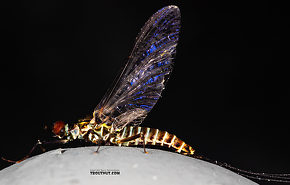 View 9 PicturesThis spinner molted from this dun, or possibly one other dun I had in the same container that looked just like it.
View 9 PicturesThis spinner molted from this dun, or possibly one other dun I had in the same container that looked just like it.
 View 9 PicturesThis spinner molted from this dun, or possibly one other dun I had in the same container that looked just like it.
View 9 PicturesThis spinner molted from this dun, or possibly one other dun I had in the same container that looked just like it.See 7 more specimens...
Mayfly Species Ameletus cooki
These are very rarely called Dark Brown Spinners.
Mayfly Species Teloganopsis deficiens
These are very rarely called Dark Brown Spinners.
Anglers in western Wisconsin, where these little flies hatch in good numbers on summer rivers, have termed them "Darth Vaders" because of the very dark color of their wings.
Until recently, this species was known as Serratella deficiens.
Until recently, this species was known as Serratella deficiens.
Teloganopsis deficiens (Little Black Quill) Mayfly Nymph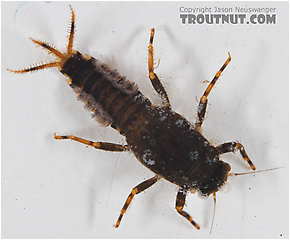 View 6 PicturesThis nymph has tiny, barely detectable tubercles (
View 6 PicturesThis nymph has tiny, barely detectable tubercles (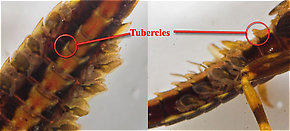 Tubercle: Various peculiar little bumps or projections on an insect. Their character is important for the identification of many kinds of insects, such as the nymphs of Ephemerellidae mayflies.) on its abdominal segments, and I could not find the maxillary palpi. I have tentatively guessed that it is Serratella deficiens.
Tubercle: Various peculiar little bumps or projections on an insect. Their character is important for the identification of many kinds of insects, such as the nymphs of Ephemerellidae mayflies.) on its abdominal segments, and I could not find the maxillary palpi. I have tentatively guessed that it is Serratella deficiens.
 View 6 PicturesThis nymph has tiny, barely detectable tubercles (
View 6 PicturesThis nymph has tiny, barely detectable tubercles (
A few (not all) of the abdominal tubercles on this Ephemerella needhami nymph are circled. They are especially large in this species.
Mayfly Species Diphetor hageni
These are very rarely called Dark Brown Spinners.
This is one of the most important species of the Baetidae family. Previously known as Baetis parvus in the West and its synonym (Synonym: A former name of a taxon, usually a species. Entomologists frequently discover that two insects originally described as different species are one in the same, and they drop one of the names. The dropped name is said to be a synonym of the remaining name. These changes take a while to trickle into the common knowledge of anglers; for example, Baetis vagans is now a synonym of Baetis tricaudatus.) Baetis devinctus in the East, it is distributed across the country but most of its fame comes from excellent hatches in the West. Prior to all the species being combined with Baetis tricaudatus, most angling literature considered it the most populous and widespread western species of the Baetidae family.
Dorsal (Dorsal: Top.) abdominal markings on the nymphs used to differentiate the species in these older works have since proved unreliable. The easiest way to tell them apart from B. tricaudatus is their lack of gills on the first abdominal segment. Telling adults apart is equally tough. Duns of D. hageni are typically a little smaller, but their bodies can also be olive, brownish olive and even two toned with thoraxes a shade of brown or tan with paler olivacious abdomens.
Diphetor hageni has two former names used in angling literature, Baetis parvus in the West and Baetis divinctus in the East.
Dorsal (Dorsal: Top.) abdominal markings on the nymphs used to differentiate the species in these older works have since proved unreliable. The easiest way to tell them apart from B. tricaudatus is their lack of gills on the first abdominal segment. Telling adults apart is equally tough. Duns of D. hageni are typically a little smaller, but their bodies can also be olive, brownish olive and even two toned with thoraxes a shade of brown or tan with paler olivacious abdomens.
Diphetor hageni has two former names used in angling literature, Baetis parvus in the West and Baetis divinctus in the East.
Mayfly Species Tricorythodes minutus
These are very rarely called Dark Brown Spinners.
Top 10 Fly Hatches
Top Gift Shop Designs
Eat mayflies.
Top Insect Specimens
Miscellaneous Sites
Troutnut.com is copyright © 2004-2024 Jason
Neuswanger (email Jason). See my FAQ for information about use of my images.
 privacy policy
privacy policy

